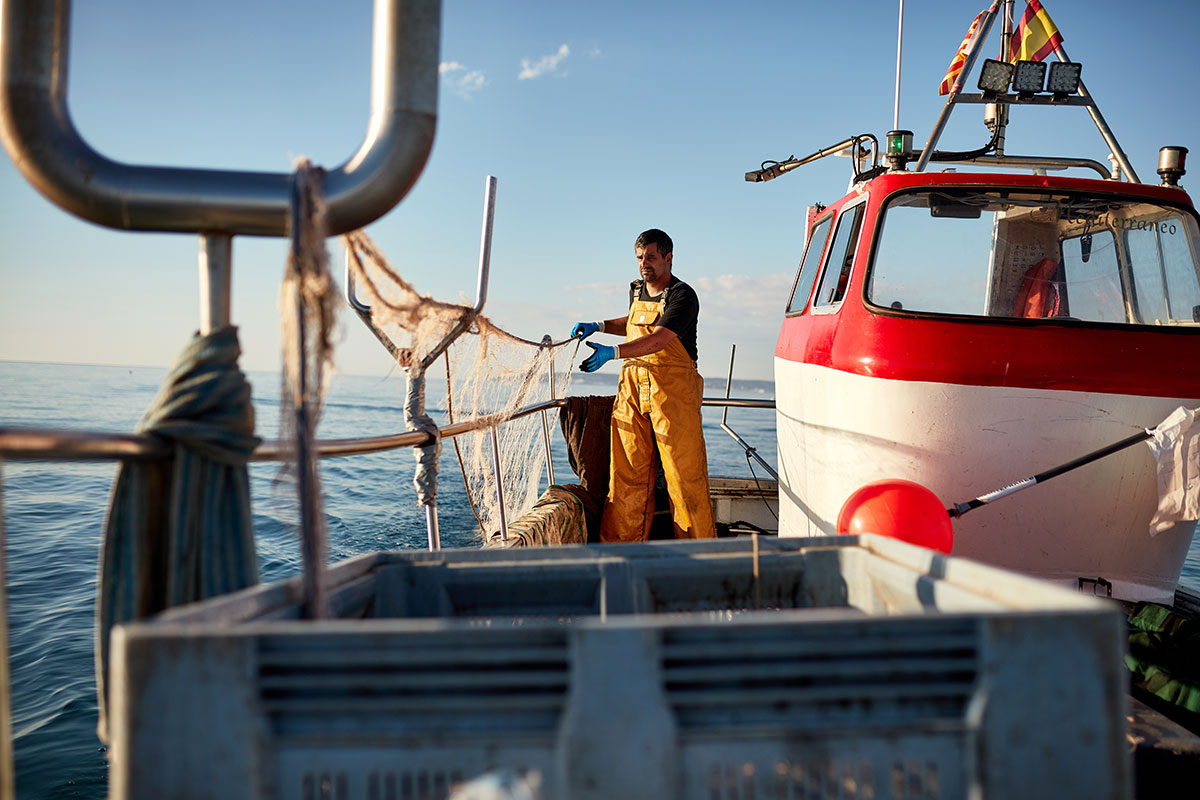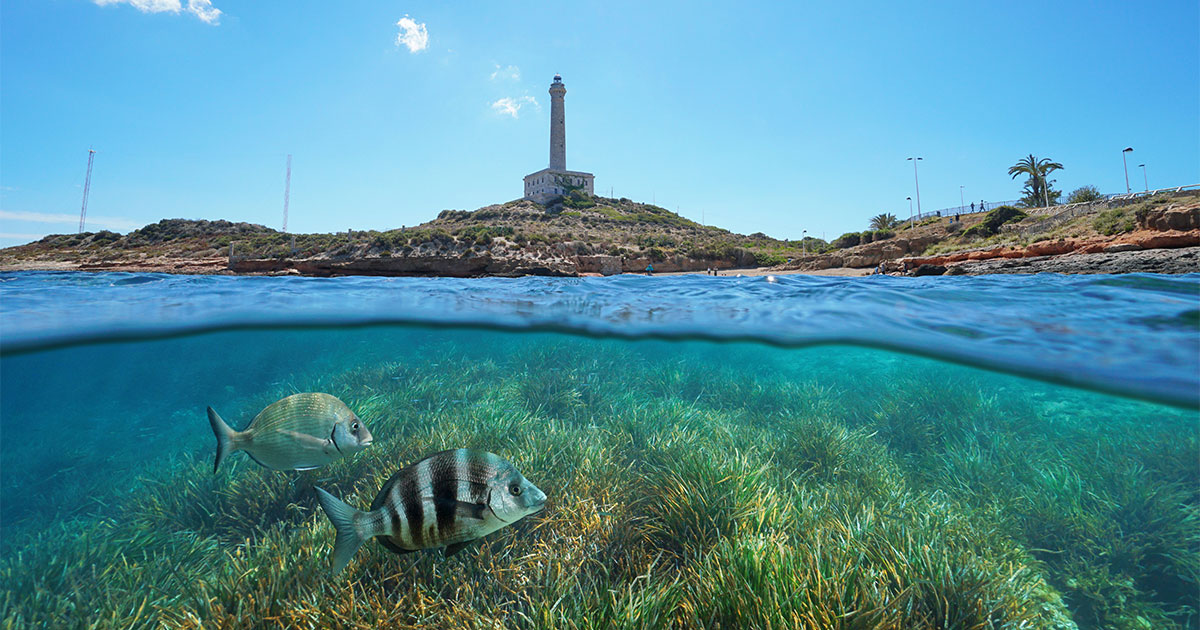The Mediterranean Sea is bordered by over 20 countries across three continents and is home to more than 15,000 islands. It is also one of the largest marine biodiversity hotspots on earth, hosting up to 18 percent of all identified marine species. An astonishing feat considering that the Mediterranean Sea represents less than one percent of the global ocean surface area.
The types of habitats found on the seabed are richly diverse ranging from vast seagrass meadows and vibrant reefs of coralline algae to deep-sea ecosystems as far as 5,267 meters. These ecosystems support prosperous sea trade and thriving fishing communities and over the ages fishing activities continued to intensify with the advancement of navigation systems and improved maritime infrastructure.
Even today fishing remains at the heart of Mediterranean traditions, providing a livelihood for around 785,000 people in an industry estimated to be worth $9.4 billion. But just as the Mediterranean Sea has influenced civilizations over the centuries, 4,000 years of maritime and fishing activity have altered the ecology of the region.
Marine habitats and species in the Mediterranean were and still are threatened by overfishing, says Charlène Minster, manager for the Mediterranean Program and Impact & Sustainability Unit at the MAVA Foundation. The spread of invasive species, climate change, and recent rising fuel costs are taking their toll on the Mediterranean fishing communities.
For decades, fishers have been hauling up increasingly smaller catches on average, forcing them to abandon historic fishing grounds in search of new, richer pastures. The movement of activity is impacting some of the Mediterranean’s most critical marine habitats and biodiversity.
According to the State of Mediterranean and Black Sea fisheries report, published in 2020 by the General Fisheries Commission for the Mediterranean, 75 percent of assessed fish stocks are still fished outside sustainable limits. And more difficulties come with the rising numbers of vulnerable species, such as sea turtles, being captured by accident (known as bycatch). And then there is the increase in conflicts between fishers and marine mammals, mostly due to dolphins preying on fish from nets and damaging fishing gear (known as depredation). Decreasing mammal and shark populations are not only a major challenge for marine conservation, but they also contribute to substantial losses of income for fishers already struggling in the current economic climate.
“If we want to make a positive impact in the Mediterranean, we must first decrease fishing efforts on high-trophic species such as swordfish, mitigate impacts of fisheries on seagrass and other habitats, and reduce negative interactions between fishers and vulnerable marine species,” explains Minster.
This can only be achieved by developing strategies and technical solutions that strengthen no-take zones and marine protected areas (MPAs), she adds. It was in response to these urgent needs that Together for the Med (TGFM) was born.
Launched in 2017, the TGFM initiative funded by the MAVA Foundation and co-led by the IUCN Mediterranean and BlueSeeds, has successfully mobilized almost 50 partners on a joint mission to connect the countries bordering the Mediterranean Sea.
Building Bridges
Situated in various locations across the Mediterranean, TGFM has brought together a dynamic group of local NGOs, regional associations, international organizations, private companies, research centers, and national representatives.
As a collective, they have launched 16 high-impact projects that aim to prevent bycatch, mitigate conflicts between marine mammals and fishers, monitor marine life and fish stocks, share scientific knowledge, help design marine protected areas, promote sustainable seafood consumption, and foster responsible marine entrepreneurship.
Each organization is benefiting by being part of the TGFM network, says Auriane Petit, project officer at BlueSeeds. “We help partners avoid duplication of efforts, provide opportunities to engage in new projects, and increase their ability to expand their work into new locations and communities that need help.”
Collaboration is Key
On Sardinia, the second-largest island in the Mediterranean, the MedSea Foundation is leading a project to restore Posidonia oceanica seagrass meadows, a priority marine habitat for the island and wider region.
Seagrass is often referred to as the “lungs of the sea”, but their value within the marine environment has been largely under-appreciated until relatively recently. Its often-vast marine meadows are hugely important for supporting commercial fisheries and biodiversity. In fact, seagrass is widely considered to be the third most valuable ecosystem in the world, estimated to be worth over $19,000 per hectare per year.

The MedSeaGrass project was hoping to develop environmental engineering solutions to help with the seagrass restoration work inside the Sinis MPA, says Petit. “At the same time, another project was developing a tool to make it easier for MPA managers to collect mooring fees. Together, they co-constructed the BlueMooring tool and raised awareness about the issues among boaters.”
After launching the new platform in January 2022, created in collaboration with BlueSeeds and funded by MAVA, boaters visiting the site can now book their own buoy. Part of the payment will be donated to support the conservation of Sardinia’s seagrass meadows.
Initiating Change
Marine Protected Areas (MPAs) are an important tool for the protection of marine biodiversity and restoring commercially important fish stocks. International negotiations are well underway to increase the global marine coverage of MPAs to 30 percent by 2030. But, as it stands today, only 8.33 per cent of the Mediterranean Sea is protected, and 0.04 percent is strictly protected. While the expansion of MPAs is crucial, without adequate human resources and funding, there is a real risk of these new sites becoming so-called ‘paper parks.’
Recognizing these challenges, most TGFM projects are dedicated to making real policy changes and advocating for stronger protection measures, says Minster. One of the group’s larger projects is working to create new MPAs and to establish no-take zones in over 25 locations all over the Mediterranean.
Several TGFM projects aim to improve the productivity of the Mediterranean Sea for future generations. By working closely with fishers and other marine stakeholders, partners on the ‘MedPath’ project are helping fishing communities better understand the importance of ocean resource management and promoting sustainable fishing practices. Other projects target fish trades, consumers, and markets at local and national levels to improve practices across environmental, social, and economic aspects.
TGFM partners are also working directly with national governments and regional fishing commissions to reduce overexploitation in fisheries and mitigate bycatch of seabirds, sea turtles, cetaceans, and elasmobranchs (including sharks, rays, and skates). The team behind the ‘MedBycatch’ project—counting 17 international partners—has been promoting synergies and joining resources to tackle incidental catches of vulnerable species in waters off the coast of Morocco, Tunisia, Turkey, Italy and Croatia.
It’s been a busy five years, says Arda. “We couldn’t have accomplished so much if we were working in isolation. Each organization understands how best to work with their national governments and local communities, and the unique challenges facing their own region. But by uniting, we are starting to see positive changes that can be felt throughout the Mediterranean.”
Establishing a Blue Legacy
MAVA’s investment in the Mediterranean Basin has been substantial, with over 420 million CHF since 1994. But now, after 28 years as a key funder of conservation, the MAVA Foundation will be closing its doors this December, creating a major funding gap for biodiversity.
This initiative doesn’t just offer hope for marine biodiversity in the Mediterranean Sea. By uniting nations and bringing coastal communities together from across the ocean, it opens a historic trade route for the exchange of a new kind of commodity: blue solutions and policies that could help shape new sustainable traditions. And for the 480 million people living in the Mediterranean region, this could mean all the difference in achieving food security and a more prosperous future for generations to come.
This feature appeared in Environment, Coastal & Offshore (ECO) Magazine's 2022 Winter edition, to read more access the magazine here.





